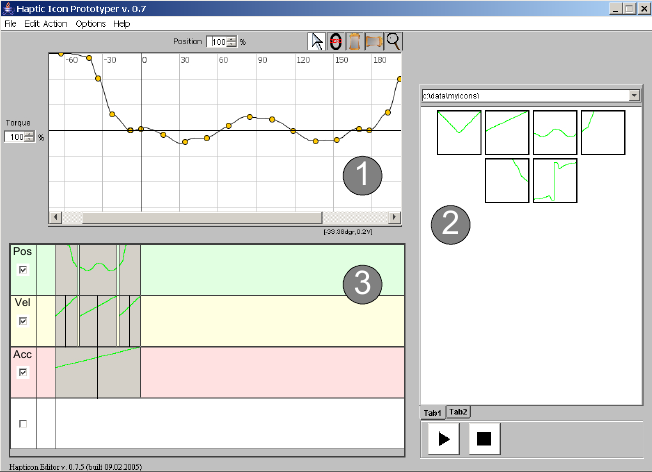Haptic Icon Prototyper

Tool Summary
| Metadata | |
|---|---|
| Release Yearⓘ The year a tool was first publicly released or discussed in an academic paper. | 2006 |
| Platformⓘ The OS or software framework needed to run the tool. | Linux |
| Availabilityⓘ If the tool can be obtained by the public. | Unavailable |
| Licenseⓘ Tye type of license applied to the tool. | Unknown |
| Venueⓘ The venue(s) for publications. | IEEE Haptics Symposium |
| Intended Use Caseⓘ The primary purposes for which the tool was developed. | Prototyping |
| Hardware Information | |
|---|---|
| Categoryⓘ The general types of haptic output devices controlled by the tool. | Force Feedback |
| Abstractionⓘ How broad the type of hardware support is for a tool.
| Class |
| Device Namesⓘ The hardware supported by the tool. This may be incomplete. | 1 DoF Knob |
| Device Templateⓘ Whether support can be easily extended to new types of devices. | No |
| Body Positionⓘ Parts of the body where stimuli are felt, if the tool explicitly shows this. | N/A |
| Interaction Information | |
|---|---|
| Driving Featureⓘ If haptic content is controlled over time, by other actions, or both. | Time, Action |
| Effect Localizationⓘ How the desired location of stimuli is mapped to the device.
| Location-aware |
| Non-Haptic Mediaⓘ Support for non-haptic media in the workspace, even if just to aid in manual synchronization. | None |
| Iterative Playbackⓘ If haptic effects can be played back from the tool to aid in the design process. | Yes |
| Design Approachesⓘ Broadly, the methods available to create a desired effect.
| Direct, Procedural, Additive |
| UI Metaphorsⓘ Common UI metaphors that define how a user interacts with a tool.
| Track, Keyframe |
| Storageⓘ How data is stored for import/export or internally to the software. | Unknown |
| Connectivityⓘ How the tool can be extended to support new data, devices, and software. | None |
Additional Information
The Haptic Icon Prototyper consists of a waveform editor used to adjust the magnitude of a force-feedback effect over position or time. Waveforms can be refined by manipulating keyframes on visualizations of them and adjusting until a desired result is achieved. These waveforms can then be combined together in a timeline either by superimposing them to create a new tile or by sequencing them. The combination of these features is meant to support the user in rapidly brainstorming new ideas.
For more information, consult the 2006 Haptics Symposium paper.